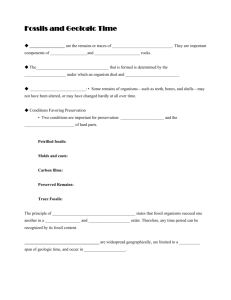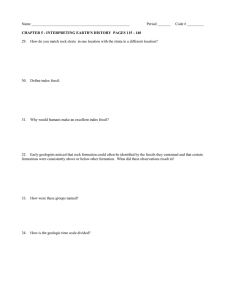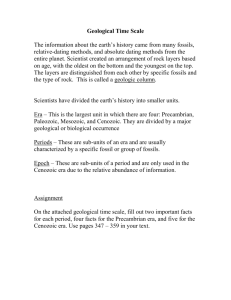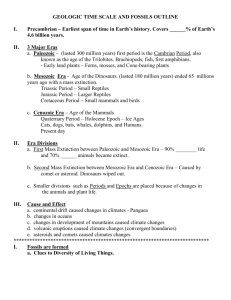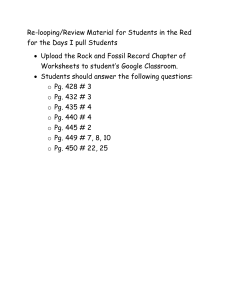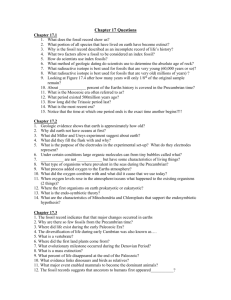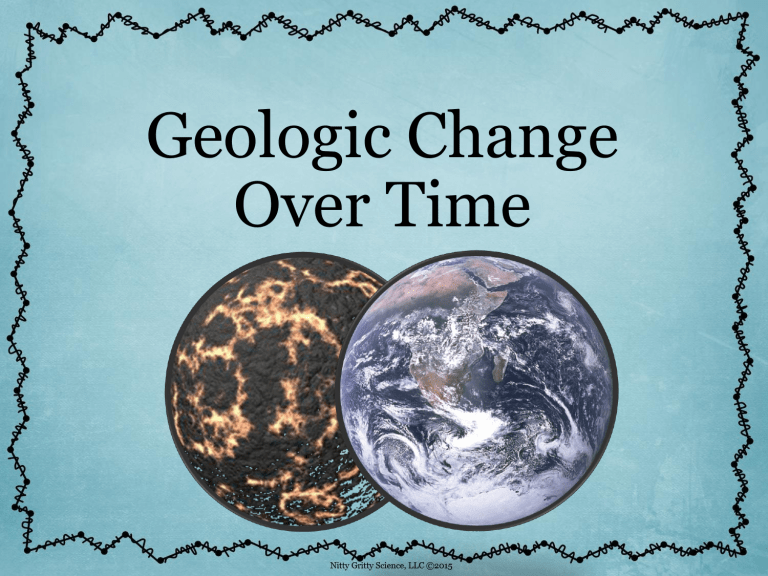
Geologic Change Over Time Uniformitarianism Both sudden & gradual changes have affected Earth’s history. Evidence of past organisms…. PRESERVED REMAINS: Some processes preserve the remains of organisms with little or no change such as those organisms that become trapped in 1. Amber (tree sap) 2. Ice 3. Asphalt or Tar NOT preserved remains… 1. buried in rock (shells, exoskeleton, bones left behind 2. petrified remains (minerals replaces organism) More evidence… TRACE FOSSILS… examples: 1. tracks 2. burrows 3. coprolite (animal dung) Fossil Record Information gathered by paleontologists is called the fossil record which provides evidence of: • Environmental changes over time • How life forms have changed over time fossils – preserved remains or traces of living things and are formed when living things die and are buried by sediments paleontologist – scientists who study, collect and classify fossils Mold mold – hollow area in the sediment which shows the shape of an organism or a part of an organism Cast cast – solid copy of the shape of an organism Petrified Fossil petrified fossil – fossils in which minerals replace all or part of an organism Carbon Film carbon film – extremely thin coating on rock Trace Fossil trace fossil – provide evidence of the activities of ancient organisms Pangaea = a single landmass (supercontinent) that broke apart almost 200 million years ago Evidence that support the landmass theory are: • The way rock types, mountains, and fossils are now distributed on Earth’s surface. Evidence of Earth’s Climate History: • Tree rings – If a tree ring is thick, it means it grew well & temp was good. If it is thin, it means there was a drought (lack of water). • Sea-floor sediments – long cylinders of sediment drilled from ocean floor. If microfossils are present, it means climate was warm or cold. • Ice – Ice cores are tubes of ice drilled out of icecaps. Scientists study the “bands” in the ice cores to see how much rain/snow fell. Classwork Pg 88-89 #20-22 Homework Pg. 90-91 Visual Summary/Lesson Review PLUS Quizlet The fossil record provides evidence to support the theory of evolution • evolution – gradual change in living things over long periods of time • scientific theory – well-test concept that explains a wide range of observations • extinct – when an organism no longer exists and never will again BELL WORK On a post it note… LINE 1 Write your name at the top LINE 2 Write your birthdate (including year) LINE 3Write your age in years & months Lesson 2 RELATIVE DATING Scientists can discover the order of events in Earth’s history by investigating surrounding evidence!! • relative dating– determine whether an object or event is older or younger than other objects or events. Scientists can discover the order of events in Earth’s history by investigating surrounding evidence!! Law of Original Horizontality – gravity causes sediment to be deposited in layers that are horizontal. Law of Superposition – in horizontal sedimentary rock layers the oldest layer is at the bottom; each higher layer is younger than the layer below it How are rock layers disturbed? • Tilting – Earth’s forces move rock layers up or down unevenly. • Folding – bending of rocks by layers being squeezed together • Fault – break or crack in the Earth’s crust (always younger than the rock it cuts through) • Intrusion – igneous rock that forms when magma is injected into rock then cools & hardens • – How are rock layers disturbed? •Extrusion – when magma reaches the Earth’s surface, cools and hardens (ex: basalt & obsidian) •Unconformity – gap in the geological record where some rock layers have been lost because of erosion Law of Crosscutting Relationships • states that a fault or body of rock (such as an intrusion/extrusion) must be younger than the rock it cuts through. See if you can put the layers in order from OLDEST to YOUNGEST. To be considered an index fossil: Must be widely distributed and represent an organism that existed only briefly Geologist use radioactive dating to determine the absolute ages of rocks • element – all the atoms of a particular type of matter are the same • radioactive decay – process by which one unstable element breaks down into another element that is stable • half-life – time required for half of the unstable element to decay Geological Time Scale Earth’s history is divided into units of time that make up a geological time scale which is divided into four major subdivisions: • Eons – longest subdivisions; based on abundance of fossils • Eras – marked by significant worldwide changes in the types of fossils present in rock • Periods – based on types of existing life globally at a particular time • Epochs – divided periods characterized by differences in life forms Geological time begins with a long span of time called Precambrian Time, which covers about 88 percent of Earth’s history and ended about 544 million years ago. Scientists hypothesize that Earth formed roughly 4.6 billion years ago. Precambrian Time (4.6 billion-544 million years ago) During the first several hundred million years of Precambrian Time, an atmosphere, oceans and continents began to form. • very few fossils remain from this time • Precambrian rocks have been buried, causing fossils to be changed by heat and pressure • most Precambrian organisms lacked hard parts Earliest life form to appear was cyanobacteria, or blue-green algae which added oxygen to the atmosphere through photosynthesis Earth’s Eras The time between Precambrian Time and the present is divided into three long units called eras: • Paleozoic era – oldest era divided into six periods • Mesozoic era – middle era divided into three periods • Cenozoic era – youngest era divided into two periods Paleozoic Era 544 million years ago to 245 million years ago Early Paleozoic consists of the Cambrian and Ordovician periods • often called Age of Invertebrates • continents covered by large, shallow inland seas • no life existed on land; Ordovician period ended with mass extinction Paleozoic Era Middle Paleozoic consists of Silurian and Devonian periods • often called Age of Fishes • some invertebrates lived on land (cockroaches/dragonflies) • continents colliding forming mountain ranges Paleozoic Era Late Paleozoic consists of Carboniferous and Permian periods • Age of Amphibians (reptiles evolved from amphibians) • continental collisions led to formation of Pangaea • largest mass extinction occurred, reason under debate Mesozoic Era 245 million to 65 million years ago • often called the Age of the Reptiles • contained the Triassic, Jurassic and Cretaceous periods • dinosaurs dominated, small mammals and birds appeared • flowering plants (angiosperms) appeared • Pangaea separated into continents, oceans began to form • mass extinction from large meteorite impact scientists believe Cenozoic Era 65 million to present • Early in Tertiary period, India collided with Asia to form Himalayas, Africa and Europe collided to form Alps; Cascades and Sierra Nevadas began to form in North America • new grasses and flowering plants dominated land • mammals continued to evolve • Homo sapiens, or humans appeared about 400,000 years ago – we live in the Holocene epoch of the Quaternary period Copyright Information ©2015 Erica L Colón: Nitty Gritty Science, LLC. All rights reserved by the author. My terms for use for all products available are as follows: Purchase of this unit entitles the purchaser the right to reproduce the pages in limited quantities for classroom use only. Duplication for an entire school, an entire school system, or commercial purposes is strictly forbidden without written permission from the author: Erica Colón: NittyGrittyScience@gmail.com or by purchasing multiple licenses. Copying any part of this product and placing it on the internet in any form (even a personal/classroom website) is strictly forbidden and is a violation of the Digital Millennium Copyright Act (DMCA). You may post pictures from using this product in your classroom as long as you provide a link back to my store.

